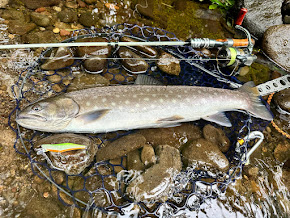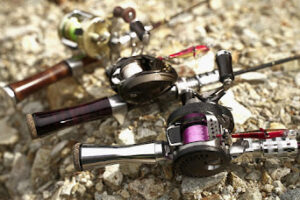Hello, this is Kamimura from Hitotoki Works.
In recent years, the use of glass materials has increased in the world of mountain stream trout fishing.
Since moving to Hokkaido in 2024, I have had more opportunities to think more deeply about glass material as I test new glass rods.
This time I would like to write about the advantages and disadvantages of glass material, and the characteristics that differ depending on the material.

What is the difference between S glass and UD glass?
Stream rods are made of S glass, which is the most common glass material, and UD glass, which is only used in a few cases.
The two materials simply differ in hardness (tension).
S glass: Strong tension
UD Glass: Weak tension
So how does this affect fishing?

The taut S-glass allows the angler's action to be easily transmitted to the rod, making lure control easy.
Although it is superior, it is still far inferior to carbon materials.
This material is suitable for fishing where lures often need to be given action.
UD Glass has no tension, so the angler's actions are less likely to be transmitted to the rod.
This makes the lure less maneuverable.
Although the hooking performance will also decrease, the sensation when casting and when a fish is hooked is pleasant, making it a material that can be enjoyed for reasons other than catching a fish.
What is the biggest drawback of glass?
As mentioned earlier, even if the angler tries hard to act and hook the fish, the rod absorbs the power and it is not transmitted to the lure or the fish.
Another thing is that the hooking rate is greatly affected by the size of the fish.
The effect is less noticeable on fish over 30 cm, but is particularly noticeable in fish around 20 cm.
If the fish is small, it will move closer to you when you hook it, which makes it harder to transmit the hooking power.
How to cover the disadvantages

While the rod itself absorbs power, it is possible to compensate for this in other areas.
● The line system is designed to be non-stretchy
●Drag is fully locked
● The hook has a thin shaft
Using thin-shaft hooks may be difficult in areas where there are only large fish, but with a glass rod the chances of the hook being stretched are reduced.
The reason will be explained later.
What are the advantages of glass?
Maybe you no longer see much point in using glass rods?
What is the reason for using a glass rod which at first glance appears to have inferior performance?
1. High casting performance
Rather than saying that it has high casting performance, it is easier to cover up mistakes because the rod returns slowly when casting (wide release point), and the rod bends just by the weight of the rod itself, making it easy to cast lightweight lures.
2. Not easily broken
Because it is a more resilient material than carbon, it can withstand strong force and has a high ultimate strength, making it easy to handle even unexpected large fish.
3. If you can hook it, it's hard to get away
When dealing with fish around 20 cm in size, you often won't even get to this starting line, but once you've hooked the bait, the cushioning of the rod will absorb the impact of the fish and make it less likely to come off.
The fish also tend to run in the opposite direction to the direction it is pulled, and the stronger the pulling force, the more thrashing they tend to do.
This is one of the reasons why the fish are less likely to thrash around than with a carbon rod, making them less likely to come off.
4. Fun
Just by casting, you feel like you are throwing, and even after you hook a fish, the rod bends even more, making it fun.
In the end, this is probably the biggest reason, rather than performance.

Hitotoki Works rods use S glass
Hitotoki Works' fishing style is one that favors active fishing.
We believe that adding action to lures and adding a reaction element will make a difference in your catch. The glass rods we make are...
The best of both glass and carbon
To achieve this we have adopted S-glass, which offers excellent operability and hooking performance while retaining the unique fun of glass.
Furthermore, the rising star GLASSY47, scheduled for release in 2025, has been designed with a fast taper that improves butt power, significantly improving operability and hooking performance.
Throw with the tip and catch with the butt!

It is scheduled to be released around March 2025!
▼It is also explained in the video▼

